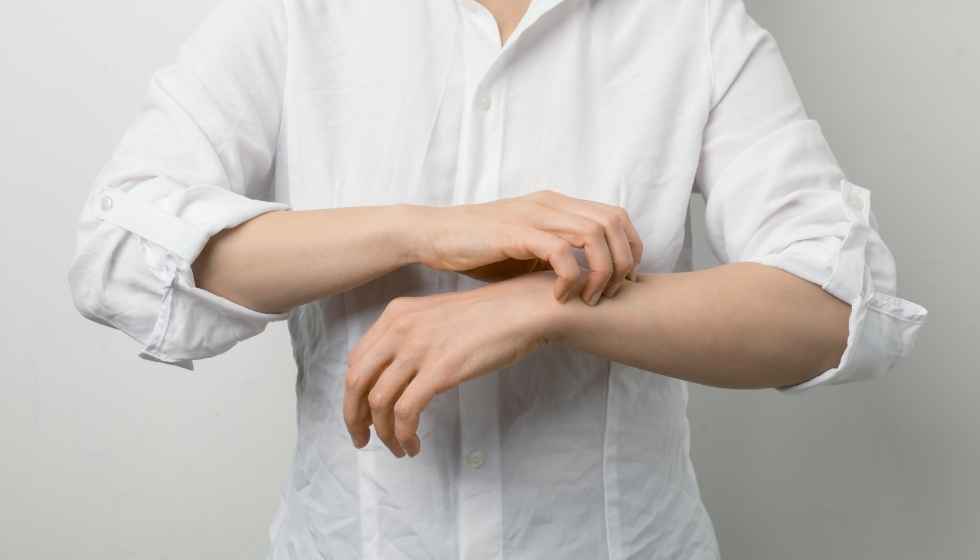What Is Scabies?
Scabies, also known as the seven-year itch, is a contagious infestation of the skin by the mite Sarcoptes scabiei. The most common symptoms are severe itching and a pimple-like rash. Occasionally small burrows can be seen in the skin.
A person will usually develop symptoms between two and six weeks in a first infection, and symptoms can start in as little as 24 hours during a second infection.
These symptoms may be present over most of the body or only in certain areas, such as the wrists, between the fingers, or along the waist.
The head may be affected, but this is typically only in young children. The itching is often worse at night, and scratching can cause a break in the skin and further bacterial infection.
What are the Scabies Symptoms?
Scabies is caused by infection with the female mite Sarcoptes scabiei var. hominis. The mites burrow into the skin to live and lay eggs.
The symptoms of scabies are due to an allergic reaction to the mites. Often only 10 to 15 mites are involved in an infection. Scabies is most often spread during a relatively long period of direct skin contact with an infected person (at least 10 minutes), such as during sexual intercourse or cohabitation.
The spread of the disease can occur even if the person has not yet developed symptoms. Crowded living conditions, such as those found in daycare centres, group homes, and prisons, increase the risk of spread.
Areas with a lack of access to water also have higher illness rates. Crusted scabies is a more severe form of the disease. It usually only occurs in people with a poor immune system, and people can have millions of mites, making them much more contagious.
In these cases, the spread of the infection can occur during brief contact or through contaminated objects. The mite is tiny and is usually not directly visible.
Diagnosis is based on signs and symptoms. The spread of infection can occur during brief contact or from contaminated objects. The mite is microscopic and is usually not directly visible.
Diagnosis is based on signs and symptoms. The spread of infection can occur during brief contact or from contaminated objects, and the mite is microscopic and is usually not directly visible. Diagnosis is based on signs and symptoms.
What Symptoms Does Scabies Have?
Characteristic symptoms of a scabies infection include intense itching and shallow burrows. Burrow tracks are often linear, to the point where an ordered “line” of four or more closely localized, almost fully developed, mosquito-like “bites” is virtually diagnostic of the disease because the host develops the symptoms reaction to the presence of the mites over time, typically there is a delay of four to six weeks between the start of the infestation and the onset of itching.
Similarly, symptoms often persist for one to several weeks after successful mite eradication. As stated,
Itch
In the classic scenario, itching worsens with heat and is generally perceived as worse at night, possibly because of fewer distractions. As a symptom, it is less common in the elderly.
Eruption
Superficial burrows of scabies usually occur in the area of the webs of the fingers, feet, ventral wrists, elbows, back, buttocks and external genitalia.
Except in infants and immunosuppressed people, the infection does not usually occur on the skin of the face or scalp.
The burrows are created by excavating the adult mite in the epidermis. In most people, early morning mite tracks are linear or S-shaped on the skin, often accompanied by rows of tiny mosquitoes or insect bites.
These signs are usually found in crevices of the body, such as in the webs of the fingers and toes, around the genital area, in the stomach folds of the skin, and under the breasts of women. Symptoms usually appear two to six weeks after infestation in people who have never been exposed to scabies before.
For those previously exposed, symptoms may occur within several days of infestation. However, symptoms may appear after several months or years.
Acropustulosis, or blisters and bumps on the palms and soles of the feet, are characteristic symptoms of scabies in babies.
Scabies causes a skin rash made up of small red bumps and blisters and affects specific body areas. Scabies can involve the webs between the fingers, the wrists and the backs of the elbows, the knees, the waist and navel, the axillary folds, the areas around the nipples, the sides and backs of the feet, genital area and buttocks.
The bumps (medically called papules) may be crusted with blood.
It helps to know that not every hit is a mistake. In most cases of scabies affecting healthy adults, there are no more than 10-15 live mites, even if there are hundreds of bumps and pimples on the skin.
Textbook descriptions of scabies always mention “burrows” or “tunnels.” These are small, thread-like projections, ranging from 2mm to 15mm long, that appear as fine grey, brown, or red lines in the affected areas.
Burrows can be tough to see. Often mistaken for burrows, they are linear scratch marks or welts that are large and dramatic and appear on people with any itchy skin condition.
Scratching destroys burrows, and scratching can break open the skin and cause scabbing.
Treatment of Scabies
Various medications are available to treat those infected, including permethrin, crotamiton, lindane and ivermectin creams. Sexual contact in the last month and people living in the same house should also be treated simultaneously.
Bedding and clothing used in the previous three days should be washed in hot water and dried in a hot dryer. Since the mite does not live for more than three days away from human skin, no further washing is needed.
Symptoms may continue for two to four weeks after treatment. If after this time symptoms persist, retreatment may be necessary.
Scabies is one of the three most common skin disorders in children, including ringworm and bacterial skin infections. As of 2015, it affects around 204 million people (2.8% of the world’s population).
It is equally common in both sexes, and the young and the elderly are more commonly affected. It also occurs more commonly in the developing world and tropical climates.
The word scabies is Latin: scabere, “to scratch.” Other animals do not spread human scabies. Infection in other animals is usually caused by slightly different but related mites, known as sarcoptic mange.


